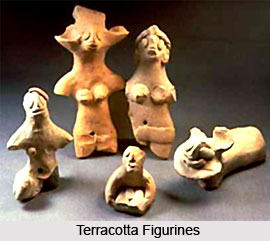 Mehrgarh emerged at the beginning of the 4th millennium B.C as a mass production centre of wheel turned pottery. The development of its craft activities is clearly betrayed by remains of workshops of lapis lazuli, turquoise, carnelian and sea-shell. Pottery, initially handmade and with basket marks and subsequently wheel turned, appears in the second period. The pear-shaped jars in fine burnished red colour indicate that they were probably manufactured on a rotating device, probably a wheel, and extended with a dabber. The very end of this period witnessed the first making of the painted ware, certainly wheel thrown and having geometric patterns. Terracotta figurines of humans and animals also make their first appearance.
Mehrgarh emerged at the beginning of the 4th millennium B.C as a mass production centre of wheel turned pottery. The development of its craft activities is clearly betrayed by remains of workshops of lapis lazuli, turquoise, carnelian and sea-shell. Pottery, initially handmade and with basket marks and subsequently wheel turned, appears in the second period. The pear-shaped jars in fine burnished red colour indicate that they were probably manufactured on a rotating device, probably a wheel, and extended with a dabber. The very end of this period witnessed the first making of the painted ware, certainly wheel thrown and having geometric patterns. Terracotta figurines of humans and animals also make their first appearance.
The main period of occupation at the site is seen around c. 3500 B.C. Domestic buildings with small, low doors, and open spaces where household activities were carried on, have been exposed. There are beautiful examples of polychrome pottery with geometric decorations in red, white and black in this period. At the same time there is a remarkable development in the range of shapes in plain ware. This includes `eggshell` goblets and sturdy storage jars.
Later periods at Mehrgarh give indications of its interactions with an impressive area extending over most of the Indo-Iranian borderlands. It continues to be a mass production centre for the potteries and terracotta images. The discovery of Mehrgarh is a pointer to the changing scenario in the socio-economic and cultural life. Beginning as an aceramic Neolithic settlement of sedentary nature with agricultural and some crafts activities, Mehrgarh in its more mature phase must have assumed a character more complex than that of a Neolithic-Chalcolithic farming community. The footsteps of the Harappan civilization perhaps can be heard in the maturation of the Mehrgarh culture.
The sustained interests of archaeologists and historians ever since the discovery of Harappan civilization in 1922 has made the study of this civilization one of the most intensely worked out facets of early Indian history with increasing sophistication.
The terracotta objects of Mohenjo-Daro and Harappa have some similarities with the artifacts of Mehrgarh. These witness that the people of later Indus civilisation may have adopted the technical processes from Mehrgarh.
Mehrgarh is considered to be the ancient town and was the source of several innovative aspects. It has been witnessed from the excavations that technology used in the artifacts of Mehrgarh was much more improved and several techniques were implemented to make the terracotta pottery and figurines elaborate. Apart from bison, the use of bulls was also seen in the Mehrgarh pottery. The people of Mehrgarh were religious and several figurines and animal structures evidence that they used to worship the animals as their gods. Some of the excavated figurines reveal the costumes and jewelleries that were used by the women in Mehrgarh.






































